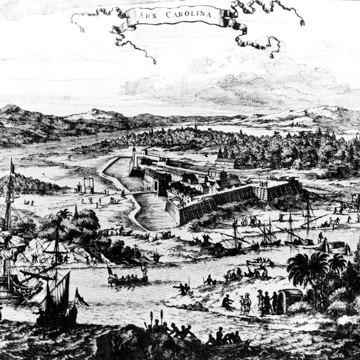Fort Caroline was one of the first French settlements in North America. One generation after Jacques Cartier attempted to create a colony in Quebec, a group of Huguenots established a sanctuary for Protestants that would prove to be the first European settlement in North America founded to protect religious liberties. Named after the King of France, Fort Caroline stood near the center of present-day Jacksonville on a strategic bluff overlooking the St. Johns River.
The current fort is a reconstruction built in the mid-1960s by the National Park Service (NPS). It is actually the second version—the first was destroyed by a hurricane soon after its completion in 1964. Archaeological evidence and historical information determined the form of the original fortress, which was destroyed by Spanish troops after they captured the site in September 1565. The fort is roughly triangular in shape, with each point modified so that the corner angles are expanded, forming protective bastions. Primarily earthwork, the structure has a plank wall facing the river on the north. It is surrounded by a moat on the two other sides and has a single timber entrance on the southeast wall.
The French settlement at Fort Caroline was intended as a commercial outpost, much like contemporary colonial efforts in Canada. Yet with the advent of the French Wars of Religion, the project assumed new importance as a potential means of resolving conflict between France’s growing Protestant minority and increasingly alarmed Catholic majority. King Charles IX agreed to let the Huguenot leader, Admiral Gaspard de Coligny, establish the colony as a Protestant sanctuary. Coligny assigned command of the initial expedition to a naval officer, Jean Ribault, who left France with 150 men in February 1562. Ribault arrived at the site of the future Fort Caroline in May, where he encountered a tribe of native Timucuans and their leader, Cacique (Chief) Saturiwa. Ribault erected a stone monument on the bluff overlooking the St. Johns River, which he called the River of May, and claimed the area for France, before leaving to establish another settlement called Charlesfort on Parris Island, in what is now South Carolina.
Fort Caroline was established two years later by a second expedition, led by Ribault’s lieutenant, Rene de Goulaine de Laudonniere. They named the settlement La Caroline, after Charles IX, and built a wooden redoubt on the bluff overlooking the St. Johns River. Initially, they were assisted in their efforts by the Timucua, with whom they enjoyed a brief period of cordial relations. Ribault, who had been detained in England, arrived soon afterwards with additional troops, settlers, and supplies.
The French colony was short-lived, however. Troops commanded by the Spanish Governor of Florida, Don Pedro Menéndez de Avilés, destroyed Fort Caroline in September 1565 in what proved to be the first combat between European powers in territory that would become the United States. The Spanish massacred the French settlers, including Ribault (who was captured in a separate incident), and destroyed the settlement. Menéndez established St. Augustine to serve as his base of operations; the fortified location expanded to become the oldest continuously occupied European settlement in North America, and the road Menéndez cleared between St. Augustine and Fort Caroline became the first regularly used highway in the future United States. While the Spanish justified the massacre of Protestants in terms of combating heresy, Menéndez confessed to Philip II that a French installation on the east coast of Florida would have threatened Spanish ships following the Gulf Stream on their route from Havana to Spain, and would eventually attack the Spanish colonies in Cuba and Puerto Rico.
Attempts to commemorate French colonial history in Florida began in the 1920s, when the Florida chapter of the Daughters of the American Revolution made the case to mark Ribault’s arrival at the St. Johns River. Prompted in part by rivalries with Virginia and Massachusetts over the origins of European settlement and religious liberty in the United States, they wanted to emphasize the role of Protestants—and Florida—in the nation’s founding. In 1924, Florida sculptor Charles Adrian Pillars created a memorial column, which was installed on donated land near Mayport. However, the monument became inaccessible to the public when it was incorporated into a new U.S. Naval Station in 1941. It was eventually moved to its current location at the Fort Caroline National Memorial in 1958, five years after the National Park Service site was established.
References
Bennett, Charles E. Laudonnière and Fort Caroline: History and Documents. University of Alabama Press, 2001.

